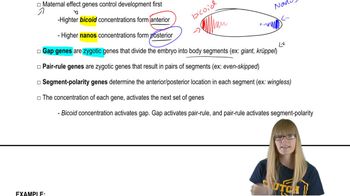Table of contents
- 1. Introduction to Genetics51m
- 2. Mendel's Laws of Inheritance3h 37m
- 3. Extensions to Mendelian Inheritance2h 41m
- 4. Genetic Mapping and Linkage2h 28m
- 5. Genetics of Bacteria and Viruses1h 21m
- 6. Chromosomal Variation1h 48m
- 7. DNA and Chromosome Structure56m
- 8. DNA Replication1h 10m
- 9. Mitosis and Meiosis1h 34m
- 10. Transcription1h 0m
- 11. Translation58m
- 12. Gene Regulation in Prokaryotes1h 19m
- 13. Gene Regulation in Eukaryotes44m
- 14. Genetic Control of Development44m
- 15. Genomes and Genomics1h 50m
- 16. Transposable Elements47m
- 17. Mutation, Repair, and Recombination1h 6m
- 18. Molecular Genetic Tools19m
- 19. Cancer Genetics29m
- 20. Quantitative Genetics1h 26m
- 21. Population Genetics50m
- 22. Evolutionary Genetics29m
14. Genetic Control of Development
Developmental Patterning Genes
Problem 22
Textbook Question
Three-spined stickleback fish live in lakes formed when the last ice age ended 10,000 to 15,000 years ago. In lakes where the sticklebacks are prey for larger fish, they develop 35 bony plates along their body as armor. In contrast, sticklebacks in lakes where there are no predators develop only a few or no bony plates.In crosses between fish of the two different morphologies, the lack of bony armor segregates as a recessive trait that maps to the ectodermal dysplasin (Eda) gene. Comparisons between the Eda-coding regions of the armored and nonarmored fish revealed no differences. How can you explain this result?
 Verified step by step guidance
Verified step by step guidance1
Understand the genetic basis of the trait: The lack of bony armor is a recessive trait that maps to the Eda gene. This means that the phenotype is determined by variations in the Eda gene or its regulation.
Analyze the coding region comparison: The problem states that there are no differences in the Eda-coding regions between armored and nonarmored fish. This suggests that the coding sequence of the gene itself is not responsible for the phenotypic difference.
Consider regulatory elements: Since the coding region is identical, the phenotypic difference may arise from variations in regulatory elements of the Eda gene. These elements control the expression of the gene, determining when, where, and how much of the gene product is produced.
Investigate epigenetic factors: Another possibility is that epigenetic modifications, such as DNA methylation or histone modifications, could influence the expression of the Eda gene without altering the coding sequence.
Examine environmental influences: Environmental factors might interact with the regulatory elements or epigenetic modifications to influence the expression of the Eda gene, leading to the observed differences in bony armor development.
 Verified video answer for a similar problem:
Verified video answer for a similar problem:This video solution was recommended by our tutors as helpful for the problem above
Video duration:
3mPlay a video:
Was this helpful?
Key Concepts
Here are the essential concepts you must grasp in order to answer the question correctly.
Phenotypic Plasticity
Phenotypic plasticity refers to the ability of an organism to change its phenotype in response to environmental conditions. In the case of the three-spined stickleback fish, the presence or absence of predators influences the development of bony plates, demonstrating how environmental factors can lead to different physical traits without altering the underlying genetic code.
Recommended video:
Guided course

Mutations and Phenotypes
Eda Gene and Its Role
The ectodermal dysplasin (Eda) gene is crucial for the development of bony structures in sticklebacks. While the gene itself may not show differences between armored and non-armored fish, variations in regulatory elements or other genes interacting with Eda could influence its expression, leading to the observed phenotypic differences.
Recommended video:
Guided course

Segmentation Genes
Genetic Regulation and Expression
Genetic regulation involves mechanisms that control the timing and level of gene expression. In sticklebacks, the lack of observable differences in the Eda-coding regions suggests that regulatory sequences, rather than the coding sequence itself, may be responsible for the variation in bony plate development, highlighting the complexity of genetic expression beyond simple Mendelian inheritance.
Recommended video:
Guided course

Penetrance and Expressivity
Related Videos
Related Practice
Textbook Question
The Hoxd9–13 genes are thought to specify digit identity (see Figure 18.18).You wish to examine the effect of loss-of-function alleles in developing limbs. How would you construct a mouse in which the function of Hoxd9–13 is retained during anterior–posterior embryonic patterning but is absent from developing limbs?
351
views


